| Danza | Canadá | ||||||||||||||||||||||||||||||||||||||||||||||
Erika Batdorf, coreógrafa, maestra de danza y mimo, Canadá (Estados Unidos) |
Traducido por Margie Díaz Mesén, Costa Rica. A Erika Batdorf se la conoce como comediante, bailarina y artista de vanguardia de las artes de la representación. Sus conocimientos en el entrenamiento para el movimiento disciplinado, la actuación tradicional y su experiencia como escritora se combinan en sus espectáculos unipersonales que son altamente emotivos. | 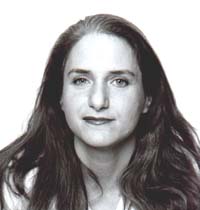 Erika Bardorf, 1998 |
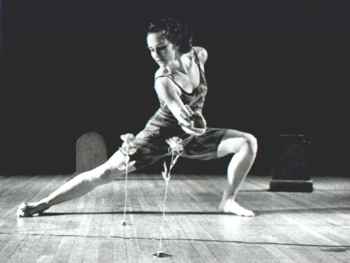 Erika, en su presentación Je t'attends: facing east.
Erika, en su presentación Je t'attends: facing east.
| Je t'attends: facing east [Te espero: hacia el este], es una presentación unipersonal de 75 minutos (que incluye 3 'pausas') donde se exploran distintas relaciones con la muerte, la ira, el dolor y
la alegría. Al usar canciones, discurso y movimiento como plegarias físicas para invocar las almas de tres de sus mentores, la composición cruza la línea entre la danza y las artes de la representación. |
|
>> The watcher and the watched [El observador y el observado], 90 minutos (incluye 45 minutos de discusión con el público). Esta representación tipo conferencia explora de una manera informativa, provocadora y humorística los estereotipos sobre el género utilizando el movimiento y el |
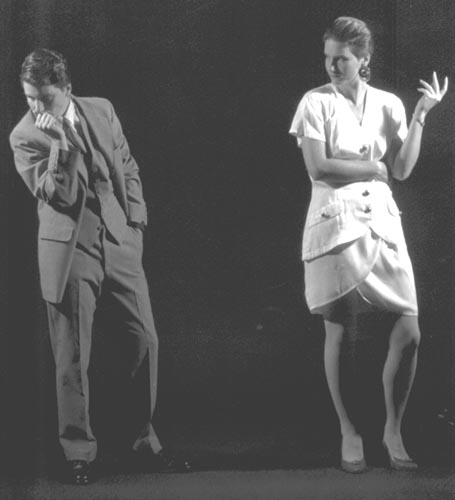 Dos distintas representaciones de Erika en
The watcher and the watched
Dos distintas representaciones de Erika en
The watcher and the watched [El observador y el observado], 1994. |
| vestuario. Batdorf actúa vestida de hombre, de mujer y en 'un género más neutral', con ropa para gimnasia.
Desde 1983, Batdorf ha actuado en el teatro original del movimiento, para el que también ha dirigido y hecho coreografías. Sus presentaciones unipersonales se han llevado a cabo en lugares como el Instituto Smithsoniano, The Fine Arts Museums [Los Museos de Bellas Artes] en San Francisco, Landegg Academy [Academia Landegg] en Suiza, y la Universidad de Harvard. Sus obras se han presentado en el Movement Theater Festival International [Festival Internacional de Teatro del Movimiento] y el Women's Theater Festival [Festival de Teatro de Mujeres] en Filadelfia; el Repertory Theatre [Teatro Repertory] en Providence, Rhode Island, y en la ciudad de Nueva York; en el Stella Adler Conservatory [Conservatorio Stella Adler] y el So Grand Studio's Movement Theater Festival [Festival de Teatro del Movimiento del Estudio So Grand]. Batdorf fue la artista estelar de la Cumbre Global de las Naciones Unidas en Copenhague y directora de movimiento para la obra El rey Lear, para "The Company of Women" [La Compañia de Mujeres] de Kristin Linklater y Carol Gillagan, en la que Linklater actuó representando el papel de Lear. Bartdorf ha sido profesora en la Universidad Brandeis, en el Emerson College, y en la Universidad de Alaska en Anchorage. En este momento enseña en el Boston Conservatory [Conservatorio de Boston] y en su propia escuela The Bartdorf School For Movement Theater [La Escuela de Batdorf para el Teatro del Movimiento]. Allí un grupo de profesores imparte cursos acerca de la espiritualidad y las artes de la representación, así como la coreografía, la voz, la actuación y laboratorios sobre los aspectos físicos y emocionales del movimiento, entre otros.
Summarized from the BAFA newsletter, June 1994, páginas 11 - 14 |

|
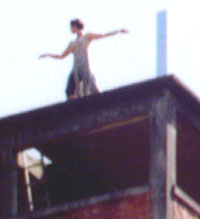 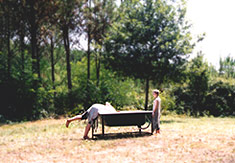 |
|
A 45 min choreographic piece with a ten year old child in six locations along a circular path in the festival grounds, which was repeated continuously. The piece included 10 minute breaks between a few of the locations, such as lying and singing inside a feathered tree trunk and sleeping in 'garden' area.
The work started with movements on the roof of the tower of the factory building. Batdorf then moved down the stairs and through the gallery part of the building, where the audience, learnt to move as she approached them, if they were on the stairs. The movements were influenced by a theme at each location. These were "independent investigation", "balance", "prayer", "trust" and "power" and she also interacted with a carved sculpture by the another festival guest, the Romanian artist, Maximus Dumitras. She also moved on or into the sculpture's Christophe Doucet, such as getting into the feathered tree trunk, in which the ten year child was waiting. They also performed in and around a bath (full of water). |

| 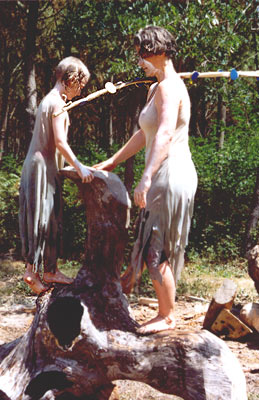 |
|
Above Right: This part of the work concerned the themes of "balance" and "trust", where Batdorf balances the sculpture by Maximus Dumitras on her shoulders while the child follows her steps over and around the sculpture by Christophe Doucet.
Right and Below: This part of the work was influenced by the theme of "power". The child tried to touch the stick, which symbollised "rules" or "laws" and once he grabbed it, then dropped it, at the moment that Batdorf drops it as well. | 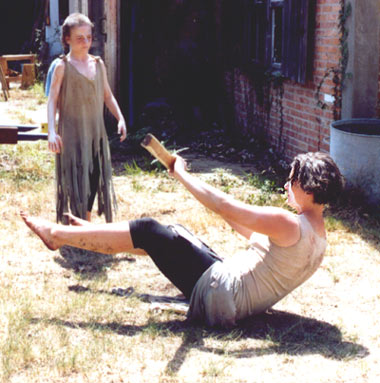 |
 Tama and Erika performing at the 2nd Performances Conditionelles Festival, France, 2003. Sculpture by Christophe Doucet on the left. |
 Performance at the 2nd Performances Conditionelles Festival, Taller, France, 2003 |